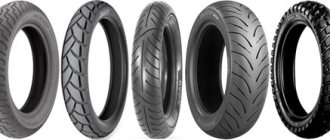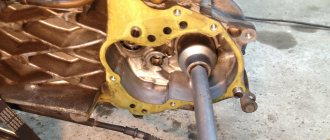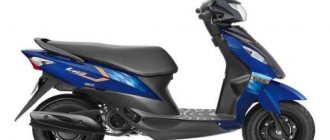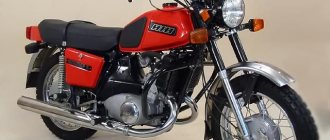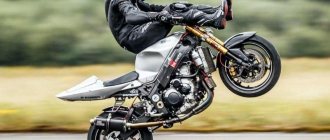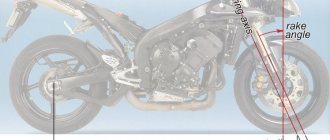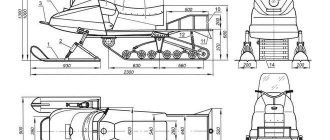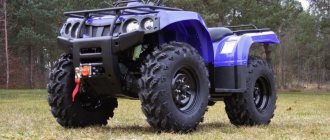MY MOTORCYCLE
A lever fork is one of the main attributes of any stroller, and certainly a shit climber can’t do without it. For example, in the West, people generally cannot imagine a motorcycle with a sidecar equipped with a telescopic fork - for them the lever is the first gadget that needs to be installed on the sidecar alone.
Of course, I’m not a designer, and I don’t have any special knowledge. This article is written from the perspective of an ordinary person, and may contain many erroneous ideas. The “drawings” given here are also probably not drawn very correctly, but if anyone is interested, then in the future I can post a 3D model of the product in 3dm Rhinoceros format. I’ll say right away that the fork was originally made with a very critical error, as a result of which it broke at the most inopportune moment. This led to an accident, but fortunately no one was injured. I'll talk about this at the very end of the article.
So, making a lever fork is the easiest way to get a durable, long-travel motorcycle fork. However, despite the apparent simplicity of its design, I personally encountered unexpected difficulties, which, however, I was able to overcome after understanding their cause.
A friend gave me 2 ready-made feathers and a pendulum blank, and I started from these details when developing my product.
My tasks were as follows:
- Increase ride comfort over uneven surfaces;
- Raise the front of the motorcycle as much as possible. This was required to increase clearance;
- Reduce the overhang (trail) to the minimum acceptable value in order to facilitate steering both on bad roads and on asphalt;
Based on these tasks, using CAD, I quickly made a model of the fork along with the motorcycle frame, checked everything, and made a swingarm from a round pipe. But this pendulum did not satisfy me with its low rigidity, so I threw it away. I had to redraw the project and weld a new pendulum from a St-3 25x40x2 profile pipe. This pendulum turned out to be very rigid. The only place in it that requires explanation is the bushings for the wheel axle. The bushings are solid, steel, and the axle is simply passed through them and secured with a nut. The wheel and brake drum are secured against axial displacement by a spacer sleeve. The axle play is eliminated using brass bushings that I made from 12 gauge brass sleeve.
I assembled the pendulum in a certain order. First the end tubular sections were cut out, then I welded the bushings to them. After this, the welding points between the bushings and the pendulum were reinforced with side plates, welded in a circle. Then, having threaded the axle through the bushings, I welded the main sections of the pendulum to the end sections. The next step is welding the shock absorber mounting ears. In the end, I realized that it was easier to install the ears on a fully assembled swingarm, and welded the rear bridge to it. It was then that I encountered the problem of the product moving away during welding, but I easily straightened the bent pendulum using a jack. Then I installed reinforcing pads under the ears for attaching the feathers, and then the ears themselves. Next, it remained to install the gussets on the connections of the pendulum jumper, and I did this, spreading its ends with a jack so that it would not move away. All ears should be welded by passing a pin through them to control the location of all parts; It is convenient to measure the size from the inserted wheel axle.
Next, I installed the upper shock absorber mounting lugs on the stays, and my fork, in general terms, was ready for fitting. I decided to install silent blocks in the bushings of the feathers, but I couldn’t find anything suitable in auto stores. Silents had to be made from scrap materials: the rubber bushing of the passenger footrest was ideal, and steel bushings with an internal diameter of 12 mm were found on the farm. The wheel axle was made from the rear wheel axle, the “thick” part of which had to be ground 30mm so that the long narrow part, 20mm in diameter, would fit through both bushings.
Now I must say a few words about shock absorbers. Initially, I lengthened the standard Ural shock absorbers, and replaced the “native” mount with a silent block. A silent block on a tube leg was attached to the body by welding. I will not describe all my torment associated with selecting the optimal shock absorber length, but I will say right away that it is now 370mm. Subsequently, on one of these ancient KMZ products, my stem broke, and I replaced them with a Chinese analogue. I also welded tubes for silent blocks onto their lower mount. A little more time passed, and I replaced the Chinese dinners made from someone’s feces with old Soviet ones. From that moment on, everything became good, and I have been driving these shock absorbers for a year now without any problems.
The reaction rod of the brake shield is attached to the pendulum. On the one hand, this solution seems good to me, since it does not require any additional tricks. Usually the rod is attached to the feather, and this necessitates allowing the shield to swing relative to the pendulum. In my case, the shield always remains motionless and can be tightly clamped between the bushings of the pendulum and the hub. In general, the anti-dive of the fork is regulated by the location where the torque rod is attached. In my case, when braking, the motorcycle not only doesn’t bite, but on the contrary, it lifts its nose. That is, the force stretching the fork is too strong for me. But since I use standard, very sluggish brakes, I’m not worried about the health of the suspension. In practice, I have never experienced any “reverse breakdowns” in shock absorbers. If you attach the reaction rod a little higher, on the feather, you can ensure that the motorcycle does not receive any trim at all when braking.
So, I installed the entire structure on the motorcycle, figured out how the wing would be attached, and welded the corresponding ears to the feathers. Now the tests could begin.
At low speeds on a dirt road, the motorcycle behaved just fine, but as soon as I accelerated, I lost all control over the car, I began to wobble from side to side, as a result of which I almost rolled over. Obviously, this is how problems with the geometry of the fork manifested themselves, namely, with its offset, or trail. Through various observations, measurements, modeling and experiments, I realized that too weak shock absorber springs, as well as unadjusted rebound valves, were to blame. At low speeds, the shock absorbers at least managed to work out all the irregularities and return to their original state, but as the speed increased, they no longer coped with their job and were constantly in a semi-compressed state.
The fact is that a lever fork with a geometry like mine, when the pendulum rises on uneven surfaces, tends to greatly reduce the reach. With strong compression of the shock absorbers, it decreases to almost zero, and sometimes can reach negative values. Naturally, this causes loss of control of the motorcycle at high speed.
I solved the problem simply. It turned out to be sufficient to adjust the shock absorber valves and increase the spring preload to increase their stiffness. I tightened the springs by 15mm, placing spacer rings under them. 15mm was taken based on the fact that the shock absorbers sagged exactly by this amount when I sat on the motorcycle tank.
As I wrote above, this improvement led to a break in the rod of one of the shock absorbers: old Soviet shock absorbers, in fact, are almost impossible to adjust. They were replaced by the Chinese with good Soviet springs and the same spacer rings.
Not knowing grief, I traveled all winter, and then, in the spring, we went to the Smolensk region. It was then that trouble happened to us. On a very rough road, both forks broke, causing the motorcycle to overturn. At first we didn’t quite understand what had happened, since the fork did not fall apart, but after driving another 500 meters and flying into a ditch, we realized that something was wrong here.
And indeed, an autopsy showed that both “crowbars” were cracked along the groove that was made so that they would fit into the cross beams. The cause of the breakdown was obvious. A sharp step between two diameters served as a stress concentrator. Due to constant vibration and stress, mainly aimed at “bending” the feathers, cracks appeared on their back side. The chainstays straightened out, the trail became negative, and the motorcycle lost control.
All this could have been avoided if the transition from one diameter to another had been smooth. But ideally, cuttings were also needed, which would relieve the feathers. The broken fork was promptly welded, I also welded these same cuts from the fittings. After that, she traveled another thousand kilometers, and upon returning home, I immediately rushed to my friend, who helped me make this fork, to make new powerful feathers.
To make a completely indestructible fork, we welded feathers from “crowbars” from a standard Soviet “telescope”. One lever pen requires one and a half telescopic crowbars. They are connected using bushes secured with electric rivets. Next, the connection is scalded. We retained the original geometry. The difference with the old feathers was the absence of any grooves and the presence of bevels made from pipes. Since the lower traverse is located inside the resulting diamond, it is not removable. That is, the fork can no longer be completely disassembled - the lower yoke is movable, but it will remain with the fork forever.
After this improvement, any problems disappeared, and since then I have been driving without fear.
Source: www.sevprostor.ru
Flex deck
If you take a closer look at the torsional resistance of modern suspensions, you will realize that a certain range of flexibility is encouraged. Thanks to this, the system absorbs impacts caused by uneven surfaces. In turn, very rigid structures transfer these shocks to the chassis, which can cause steering wheel chatter or vibration, that is, high-frequency vibrations of the front wheel. In addition, the so-called wheel speed curve, i.e., the distance that it travels when the springs are compressed on an uneven road, is close to ideal in a telescopic fork. All other systems, including BMW Duolever, work in the opposite direction to the direction of impact, which is detrimental to comfort.
The aluminum bottom shelf can be up to 100mm high. Attached with three screws, it connects both fork legs while strengthening it. Often too much
Beautiful fixation of the thin-walled but huge front wheel axle of the MV Agusta F4
Large fork piston of the Big Piston type, which goes directly into the shins. Below that are small-diameter traditional fork pistons with rebound damping adjustment (right) and rebound damping, which are housed in a single shock cylinder (called a cartridge).
An example is the targeted flexibility of the shock absorber forks on some racing cars. Strange as it may seem at first glance, the milled upper fork flanges hold the upper shank and allow smaller or larger deformations using deep recesses. That is why massive lower shelves secured with several clamping screws on each leg have almost completely disappeared from sports and production cars.
The very large diameters of the front axles, once installed, for example, in the F-series MV Agusta motorcycles, ensure maximum torsional stability of the legs. The designers also made no changes here and left their diameter at 30-35 mm.
Over the years, many of the shortcomings of the telescopic fork design have been addressed. For example, by coating the surface of the shin with special coatings (for example, titanium nitride), friction is reduced, or by carburizing the friction of Teflon-coated plain bearings operating with sealants is reduced.
How does a fork work?
If you press on the steering wheel when you hit a bump or pothole, the inner tubes, under the resistance of the spring located inside the fork, go into its legs.
There are two types of resistance to which a bicycle can be subjected: direct shock and vibration. In the first case, the spring takes on the entire load and absorbs it inside the fork. Note that the role of a spring can be played by a steel spring or air under pressure. Vibrations are already damped by a damper, which can be an elastomer, oil or air. Thanks to the damper, the spring is not thrown back immediately, but does so smoothly and gradually. By working in this way, the fork ensures a smoother ride of the bike even in the most aggressive road conditions.
If we talk about the damper, it is worth noting that the cheapest shock absorber option is elastomer, which is made from polymer. Under constant loads, it fails quite quickly. It is better to choose an air or oil system.
Types of forks
Spring
Basic level of suspension forks. They are installed on cheap bicycle models and are sold at retail on a residual basis. They are usually used as spare parts for repairs. Due to their design, they do not act as a damper, allowing minor irregularities to pass through in full.
This fork is based on a regular spring, closed in the connecting rod under rubber or other protection. Usually it is assembled quite roughly and during use it deteriorates from the ingress of dirt. Maintenance options are limited - usually only replacing the spring itself. There are no settings either, only locks.
Disassembled spring type forkRecommended for entry-level or in situations where other options are not available for financial or other reasons.
Spring-elastomer
The mechanics are no different from the previous ones, but instead of a spring, a polymer rod is used, which acts as a damper. Unfortunately, it all depends on the properties of the material, but usually they are far from perfect. The shock-absorbing function is slightly replaced by the damping function, maintaining the overall low comfort from using the fork.
Spring and elastomer front forks are not recommended for winter use as the degradation at low temperatures is too severe.
Air
The all-air-cushioned design is very advantageous both in terms of cost and maintenance. Compressed air pumped into a sealed chamber works both as a shock absorber and as a very good damper. The ride is very comfortable, comparable to many more expensive designs, but if you buy a mountain bike, you should choose a more durable mechanism.
The disadvantage of air ones is preparation and service life. The adjustment is made only by the pressure in the chamber, since it is quite narrow, you have to pump it up very often, and the overall service life of such a mechanism, especially during aggressive skating, is short.
Oil-air
Oil-air forks split the shock and damper functions between the air chamber and the oil cartridge. If the behavior of the air “spring” is understandable and similar to the air fork, then a lot depends on the oil block. The main choice is based on the structure of the cartridge and the brand of oil.
Disassembled oil-air fork
This type of design is great for cross-country and constant riding, but fails under heavy loads on mountain slopes. In addition, the service life is expected to be lower than that of spring mechanisms.
Oil-spring
The recognized professional type of front fork is a device that combines an oil cartridge and a steel spring. These are the forks found on the best sports bikes, but depending on the cost, oil-spring designs are replaced with oil-air ones.
Typically, the possibilities for adjustment are lower than with air springs, but a spring, especially one made of modern materials, allows you to work for a very long time and with the required stiffness.
Both oil and shock-absorbing springs have gone through a great deal of improvement and together provide the best sporting combination. At the moment, the bicycle industry cannot offer any possible competitors for this combination.
[edit] Fork adjustments
The cost of a fork is determined not only by the quality of its work, the materials used and weight, but also by the number of its adjustments (and, accordingly, the complexity of the design). If, strictly speaking, one or two adjustments are enough for a simple rider or tourist, then for a rider, the more degrees of freedom in adjusting the fork for a specific track, the better. It’s even better if you can adjust the fork on the go, without taking your hands off the steering wheel. For this purpose, a special shifter is used, of which there can be up to 2 pieces per fork (for example, changing the stroke and activating the platform).
Spring adjustments:
- Preload - adjusting the precompression of the spring to the weight of the rider, either by mechanical adjustment or by pumping air into a small air chamber above the spring;
- Positive air chamber - an air chamber that acts as the main load-bearing spring. By changing the air pressure in this chamber, the precompression of the system is adjusted, adjusting the suspension force to the rider’s weight;
- Negative air chamber - increases the sensitivity of the fork at the beginning of the stroke due to the negative (reverse) effect on the uncompressed fork. In other words, the pressure in this chamber pressurizes the pressure in the positive chamber. The result is high fork sensitivity.
- Travel adjustment* - the ability to quickly change the travel of the fork without changing the damping characteristics.
- Working chamber volume (volume adjustment) - adjustment of the degree of progressive compression.
Compression damper adjustments:
- Lockout* (lockout) is a hydraulic system that provides complete locking of the fork action. Used when driving uphill only on smooth surfaces
to use 100% of the leg strength for acceleration. ; - Punchable Lock* - A hydraulic system that allows a locked fork to unlock during heavy impacts (to prevent damage to the fork).
- Adjustable platform* is a hydraulic adjustable system, the action of which is similar to a pierceable block, only the breakdown threshold can be set by a separate adjustment (floodgate) within a wide range. Allows the fork to operate only on large bumps, but not to swing on climbs.
- Compression* - hydraulically adjustable damping system when compressing the fork (usually adjustable from 0 to very high resistance). Allows the damper to reduce the compression rate of the fork. Low speed compression is a hydraulically adjustable damping system that creates little resistance when the fork is compressed slowly at low speeds, but is disabled when the fork is compressed sharply at high speeds. Reduces fork sway during active pedaling and bike “dive” when braking.
- Compression at the end of the stroke (bottom out) is an anti-breakdown hydraulic system (relevant for spring forks), which begins its work when the fork has already compressed ~80% of its stroke and continues to compress. The anti-collision system is designed to prevent the metal parts of the fork from hitting each other when the fork has worked its full stroke.
Rebound damper adjustments:
Rebound speed is a hydraulically adjustable system that operates during rebound when the fork unclenches.
Adjustment options:
- External adjustment - at the dropout (most common) or on the crown;
- Internal adjustment - requires partial disassembly of the fork.
ETA (extension travel adjustment) is an analogue of the fork lock from Marzocchi. After turning on the system, the fork must be compressed, after which its operation is completely blocked at ~60% of the total travel.
Types of bicycle forks
Depending on the springs and dampers used, and their combination, the following shock absorber configurations exist:
All of the above applies to conventional plugs, which are most often used in production. They are simple and effective as a shock absorber.
In addition to conventional suspension forks, you can often find so-called “upside-down” forks, which are essentially an inverted type of regular fork. “Shifters” are characterized by greater strength than a conventional shock absorber and better rolling on uneven surfaces.
There are also specific forks with a more complex multi-piston and multi-link damping system. This type also includes forks with one leg.
When choosing a fork as a reliable assistant in conquering trails with any surface, you need to make sure that the manufacturer has a certified representative in Russia, and that there is a collection point for defective or faulty products in your city.
A lot of good things
About 20 years ago, the guys from Bimota and Yamaha, like Pinky and Brain of the cartoon, planned to take over the world with motocross motorcycles. In the case of Yamaha we are talking about the GTS 1000, in Bimota we are talking about the even more technically complex Tesi model.
The sport tourer GTS 1000 failed to translate its theoretical merits into everyday use, which is probably why it was not a bestseller among others, which is why it disappeared from the market after five years. Although the Tesi can still be purchased, it is a motorcycle for fans of the brand and alternative solutions. The design solutions of both motorcycles had many disadvantages: they were technically complex and, therefore, expensive to manufacture, provided a turning radius that was too small for a road motorcycle, and did not provide the best transmission of torque.
Countless racing prototypes with alternative suspensions have led to the fact that today, even in racing, the compact and not very expensive USD fork rules the roost.
Types of shock absorbers
The greatest attention in forks is paid to shock absorbers, or rather, their types. Actually, the type of shock-absorbing mechanism determines how the bike will behave, what weight is available to it, what settings will be, and how long the model can last.
Let's move on to types.
Most types are two-part, because inside the fork there is a shock-absorbing unit (for example, a spring), which is responsible for the “long” stroke of the fork itself, and a damper, a unit for compensating for small shocks and vibration.
Spring
The simplest shock-absorbing mechanism is a regular spring. No tricks, materials from ordinary steel to titanium, simple and reliable mechanism. According to reliability, the price and total weight are low, however, this is achieved at the cost of losing any settings, except for replacing the spring itself and the lock.
Spring forks are usually installed on the cheapest bicycles - “auchan bikes”. They are also installed by some special fans of heavy loads, when in competitions and hikes service life is more important than the quality of shock absorption.
It is believed that a fork on a bicycle with a spring cannot be considered “suspension-absorbing,” but this is a marketing ploy
Springs do not have any harmful effects on the health or mechanisms of a bicycle, but they should be chosen with caution
Spring-elastomer
A damper appears in this mechanism. It usually consists of a rod made of elastomer, and sometimes synthetic rubber, which dampens small vibrations. In use, this type of fork is seriously superior to inexpensive spring forks, although it wins only in one parameter - comfort.
This type of fork is installed on many bicycles, and can be called the “market standard” for budget models. It is not used by professionals.
One shock absorber or two? Foaming of oil in shock absorbers.
In the good old days, all motorcycles had two rear shock absorbers. In the course of evolution, the design of two shock absorbers was replaced by a monoshock absorber. Question: why?
And the answer is quite simple. In a system of two shock absorbers, they are located quite close to the rear wheel. This means that the piston inside the shock absorber moves almost the same distance that the pendulum travels. Large bumps force the piston to travel a distance of 10 centimeters up and then down, which gives the effect of foaming the oil inside the shock absorbers. When the consistency of the oil begins to resemble a Frappuccino, the shock absorbers begin to handle bumps much worse.
A monoshock system involves mounting directly at the base of the swingarm. The pendulum moves up and down the same distance, but the shock absorber piston travels a much shorter distance than with a pair of shock absorbers. And modern progression systems further soften the load on the shock absorber. Thus, the monoshock absorber copes with large bumps more easily and handles small ones faster. Looking ahead, I would like to note that, reading the paragraph about BMW suspensions, you will understand why the shock absorber mount on the first Paralever was subsequently shifted to the very base of the pendulum - precisely because the original design with a mount at the rear wheel did not provide any advantages over the same suspension design with two shock absorbers.
Front fork maintenance and repair
You can carry out maintenance and repair of the front fork yourself.
The maintenance procedure can be divided into several main stages:
- Removal of the structure. Often the fork is attached using a threadless method, which is used by almost all manufacturers. The steering column stem is secured with a bearing, the armature goes into the tube and is secured with two screws. That is why removal is carried out by unscrewing two screws. The threaded method of application is rare today, since play may appear during long-term use of the bicycle.
- Maintenance includes cleaning. The boots and casings that operate during operation of the front fork can become very dirty. Accumulation of dirt can cause structural damage. Cleaning can only be done if there are no oil leaks from the outside.
- Replacement. When servicing, you can replace the oil, which must be branded. The spring is also subject to replacement, since with prolonged use it may lose its rigidity. There is a possibility that the air will need to be replaced due to the appearance of a large number of impurities. To do this, the old is removed and the new is supplied under pressure.
In most cases, maintenance can be done yourself. However, there are also non-separable fork designs that have to be replaced entirely.
The front fork is an important component of a modern bicycle. She is responsible for comfort while driving. Timely maintenance can significantly extend the service life.
